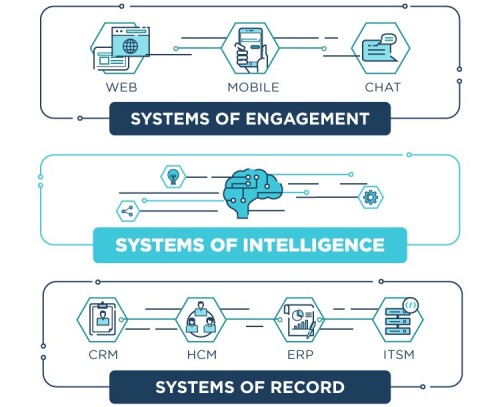
MMS • RSS
Article originally posted on Data Science Central. Visit Data Science Central
Summary: The fourth and final AI strategy we’ll review is Systems of Intelligence (SOI). This is getting nearly as much attention as the Vertical strategy we previously reviewed. It’s appealing because it seems to offer the financial advantages of a Horizontal strategy but its ability to create a defensible moat requires some fine tuning.
 In the last several articles we’ve been looking at different strategies for successful AI companies.
In the last several articles we’ve been looking at different strategies for successful AI companies.
We described Data Dominance, and the Vertical and Horizontal strategies. This brings us to the fourth and last AI strategy, Systems of Intelligence (SOI).
Systems of Intelligence strategy like the Vertical strategy is the brain child of a successful VC, Jerry Chen of Greylock Partners. Like many VCs Mr. Chen is struggling to define criteria for investing in a technology market that is changing so rapidly. So far the Vertical strategy and this Systems of Intelligence strategy are getting the most press. This may or may not indicate agreement from the investing community at large.
The single factor that ties together all four of these strategies however is the need to create a moat of defensibility that will prevent fast followers from simply copying your idea.
Old Moats Have Fallen
It’s interesting to review how the technology market has evolved over time and to remember the moats that were established in each epoch. Gil Dibner a self-described venture investor has offered perhaps the most thoughtful response to SOI, also offers us this brief historical recap of tech VC investing.
- 1970–1985: The “Silicon” Era (e.g. Intel, founded 1968)
- 1975–1990: The “Information” Era (e.g. Microsoft, founded 1975, and Oracle, founded 1977)
- 1985–2000: The “Physical Network” Era (e.g. Cisco, founded 1984)
- 1995–2010: The “Logical Network” Era (e.g. Netscape, founded 1994)
- 2000–2015: The “SaaS” Era (e.g. Salesforce, founded 1999)
- 2005–2020: The “Network Effect” Era (e.g. Facebook, founded 2004 and AirBnB founded 2008)
- 2015–2030: The “System of Intelligence” Era?
If you date the rise of modern ML and AI from the advent of open source NoSQL and Hadoop in 2007 it’s easy to spot that VC investing strategy has been dominated by the Network Effect and the SaaS strategies.
It’s not that these have become invalid. It’s that they have been fully exploited and with very few exceptions the leaders with these strategies have been established, largely freezing out future competitors. On the mind of VCs, startup founders, and all of us interested in AI-first businesses is what comes next? Mr. Chen offers:
“I believe that deep technology moats aren’t completely gone and defensible business models can still be built around IP. If you pick a place in the technology stack and become the absolute best of breed solution you can create a valuable company. However, this means picking a technical problem with few substitutes, that requires hard engineering, and needs operational knowledge to scale.”
What’s the Underlying Concept behind Systems of Intelligence?
In his seminal article on SOI, Chen makes these assertions:
- Today the market favors full stack solutions that frequently relied on the SaaS model. The details of the technology are no longer important as long as the elements of the stack function well together.
- Today’s full-stack is grounded on Systems of Record. There are four fundamental systems of record, one for your customers (CRM), one for your employees (HCM), and two for your assets (ERP financials/ITSM). These are the databases on which your applications are built. The leading players in this SaaS strategy are established and dominant.
- Systems of Engagement are the interfaces that sit atop the Systems of Record and allow or control how users can utilize and interface with the data. These have migrated up from mainframe terminals, through dashboard visualizers like Tableau, until today we have Slack, Alexa, Wechat, chatbots and every other variant on text and conversational UIs. Older SOE applications tend not to go away but continue to coexist with newer forms.
To gain competitive advantage an SOE must rely on network effect (the friendliness and utility of its interface to attract maximum users) since the data it provides resides in SORs and is shared with other SOEs. The result is today’s modern enterprise stack where SOEs reside atop SORs.
The disruptive core of Systems of Intelligence is that there is emerging a middle layer, the SOI layer that enhances the value of the SORs by adding data from multiple, sometimes external sources, or adding previously unseen insight through the addition of ML/AI.
The ability to bridge multiple SORs makes these applications more defensible against the internal capabilities of an SAP or a PeopleSoft, and adding value from external data sources (for example web logs to produce web analytics) makes their moat even wider.
Of course the ability to add value to multiple data sources relies on the value add from ML/AI.
What Do These SOI Opportunities Look Like
First of all it should be evident that this is a horizontal strategy that applies to enterprise platforms. Horizontal strategies are those that represent solutions that can be repurposed across multiple industries.
But unlike the broad horizontal strategy that requires the user/customer to adapt the solution to the specific use case requiring more effort than they are likely to want to apply, the SOI strategy most likely results in a fairly complete standardized application (full stack) around a specific set of processes. The assumption is that these are sufficiently similar across industries that adaptation and configuration can be accomplished through repeatable processes. Chen offers these three potential scenarios:
- Customer facing applications around the customer journey.
- Employee facing applications like HCM.
- ITSM, financials, or infrastructure systems like security, compute/ storage/ networking, and monitoring/ management.
The core capabilities are data blending and ML/AI analysis leading to predictive or even prescriptive actions. You could build these with modern advance analytic platforms like Alteryx, SAS, or SPSS, or simply write them in R or Python.
Of course the focus could be more narrowly a group of target companies across a more specialized industry like finance or construction. Here in addition to requiring process subject matter expertise, industry expertise would also be needed.
Does the Systems of Intelligence Strategy Provide a Defensible Moat?
It’s not clear that it does, at least without adding additional factors to the equation. One of the best discussions and criticisms of SOI comes from Gil Dibner, who self identifies as a venture investor.
The first issue that Dibner identifies is that any fast follower can recreate your product if your only advantage is expertise with ML/AI. Thanks to the open source ethos of ML/AI, none of that IP is truly proprietary.
It may be possible to achieve at least a temporary lead if the technical complexity of your solution is very high, especially in the developing arts of image, text, and speech. However, this advantage is not likely to last. AI is rapidly becoming a commodity.
There are some features that Dibner believes can add some defensibility at least in some cases. One is if the AI technology is extremely hard that we mentioned above.
Another is a variation on the Network Effect. Remember that the idea of network effect says that the value of the network becomes greater as the number of users increases. Generally this is fully exploited and no longer provides a moat.
However, Dibner envisions the possibility of Systems of Network Intelligence. He imagines a system that works across various parties in a supply chain where shared information across customers can be seen to add value.
Another possible moat he offers is the ability to integrate human-in-the-loop applications with the AI so that the resulting hybrid system learns more rapidly and more effectively than the AI alone.
At that point, Dibner starts to suggest features that are clearly from the vertical strategy: domain expertise, data dominance, and full stack applications.
The horizontal cross-industry approach of Systems of Intelligence will no doubt remain its most appealing feature. If defensible, the strength of a single process focused application that could be sold across a variety of industries sound like a pot of gold.
Whether there is any real moat here is questionable.
Other articles on AI Strategy
Comparing AI Strategies – Vertical versus Horizontal.
What Makes a Successful AI Company
AI Strategies – Incremental and Fundamental Improvements
Other articles by Bill Vorhies.
About the author: Bill Vorhies is Editorial Director for Data Science Central and has practiced as a data scientist since 2001. He can be reached at:


